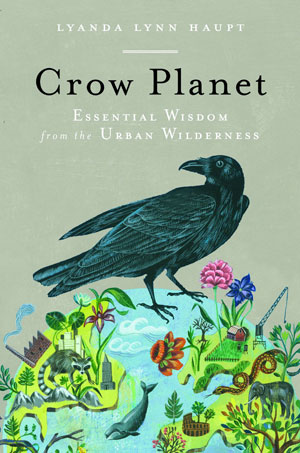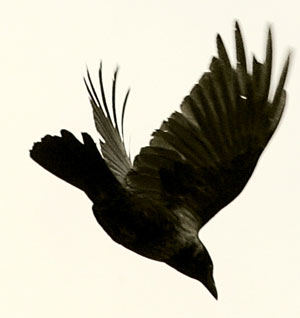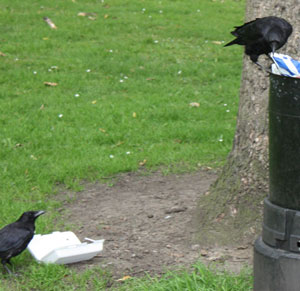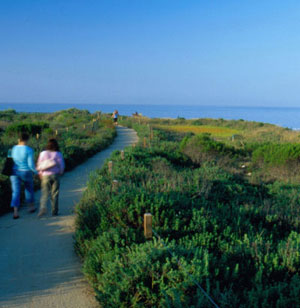If you love or hate crows
Guest post by the American Society of Landscape Architects

Lyanda Lynn Haupt is an award-winning author, speaker, and naturalist based in Seattle. Her latest book, “Crow Planet: Essential Wisdom from the Urban Wilderness“, which David Sedaris called “completely charming and informative,” received the 2010 Sigurd F. Olson Nature Writing Award. Haupt blogs at The Tangled Nest.
Your new book, “Crow Planet: Essential Wisdom from the Urban Wilderness,” is all about the relationship between people and crows in urban areas. You say it’s a bit strained on both sides. How have the issues changed over the years?
In urban places, crow populations tend to echo human populations. This means that the more concrete we make, and the more humans we make (these tend to go hand in hand), the more crows there will be among us. Just 50 years ago in Seattle, where I live, it was a big deal to see 20 crows in one place. Now, of course, there are autumn roosts in the thousands, and nearly all of us cross paths with numbers of crows every day. It’s funny to hear people say, “Where did all these crows come from?” as if their presence is some kind of sudden surprise, instead of the slow-growing outcome of years of urban planning (or lack of it) in which native habitat was chopped to bits, impervious surfaces reigned, and botanical structure was dramatically simplified. Very few native birds and creatures can survive in such places, but the adaptable, omnivorous, highly intelligent crow can.
We are all now living in Crow Planet, a place characterized by the spread of “crow-ness.” What is crow-ness? What does it say about urban ecosystems and the role people play in nature?
“Crow-ness” is the ubiquitous presence of a large, native bird right in the heart of urban places. It speaks deeply to the fact that the way we create our homes and neighborhoods—both in terms of structure and personal habits– has a lot (not everything, but a lot) to do with determining the nonhuman species that can live among us, and how we might flourish together. The title of my book is Crow Planet, which has two interrelated meanings. On the one hand, it refers to a planet (our planet) on which native biodiversity is deeply threatened, and the rich variety of species is being replaced by a few dominant, successful species—species such as crows. At the same time, “Crow Planet” invokes the idea that no matter where we dwell and no matter how urban our homes, we are implicated in wildlife, and we are informed and enlivened by the presence of native, wild creatures—again, creatures such as crows. We navigate our daily lives in light of both these truths.
New research shows that crows can recognize individual people and once someone makes it on to a crow’s shit list, it’s impossible to get off it. Are crows the only birds with this ability to recognize people? What other unique cognitive capabilities do they have?
This is actually a really fun study out of the University of Washington. The crows on campus hated the students who had trapped and banded them, and they wanted to figure out how the crows recognized them afterwards—was it their face, their gait, their tattoos? So they put caveman masks on the birdbanders, and later, students who had not banded birds wore the same mask and strolled around the places the banded birds hang out. The crows went crazy, scolding and divebombing the caveman mask wearers. So it seemed the crows recognized their faces. For a control (just to make sure the crows weren’t recognizing masked individuals in general) they put Dick Cheney masks on the non-banders, and the crows left them completely alone (yes, in this case Dick Cheney got to be the good guy!). I still wonder whether crows use other clues in recognizing individuals. It seems that they can pick out people they don’t like from a long ways away—maybe they can recognize us by our faces, but also by other cues, just as we can recognize people we know well from afar, through a sort of gestalt.
Other birds, including some species not normally considered to be particularly intelligent, like pigeons, can recognize individual people (every city park has a resident pigeon feeder, and the birds recognize them from a long ways off). And of course we know that our dogs and cats, and presumably their wild kin can recognize individual humans. I suspect that while not all animals can do it, many many can.
Obviously crows hate people who trap and band them, but the main reason they decide to dislike us is they perceive us to be venturing too close to their nest or chicks, in which case they will vocally scold us, and maybe even bodily divebomb our heads. This habit is seasonal, and it makes sense—we are big mammals, many of us hate crows, and crows have very large nests and loud young that are difficult to hide (smaller birds that can hide their nests don’t need to resort to such bold tactics). Crows are not “mean,” they are simply protective parents, and as soon as the years hatchlings are grown, the crows will usually calm down. As you say, sometimes crows will keep you on their “shit list” forever, but often, if you behave, they’ll eventually leave you in peace. During nesting season, try to avoid crow nests, or appear uninterested in them. And if the crows still hate you, you can always try wearing a Dick Cheney mask.
Crows may be the most common wild native beings that humans regularly see. However, are they truly wild given their close interaction with people and dependence on human waste for food? In their dependence on human systems, how do crows compromise to accommodate us?
If you believe that “wild” is some romanticized state that involves a lack of human presence, then crows might not seem very wild. But of course they are a native species, not introduced, not escaped from domestic stock. They are free to leave cities, and are entirely autonomous beings. They would not die without us. I consider them to be entirely wild. They have, however, adapted well to human presence—avoiding us just enough to feel safe nesting among us, while reaping the benefits of city life: french fries; gardens full of fruit, seedlings, and worms; fresh roadkill. And because most bird species cannot tolerate urban conditions, crows reap all of these benefits with very little competition.
There are compromises from the crow side—cars are dangerous, especially for naïve hatch-year birds, and many of them die on the streets; city food is not as healthy as suburban/rural food, and some researchers believe that this may actually decrease crow longevity; and it appears that things like traffic, noise, and general urban hustle-bustle may stress crow nervous systems in the same ways they stress humans.
You say most of us, unwittingly, live in a zoopolis, a multi-layered place where the city meets the zoo, an overlap of human and animal geographies. How then can landscape architects design cities so that humans and different animal species can better co-exist? Do we even want to design cities so they are more livable for species like crows?
Oh, we definitely don’t want more crows! The role of the landscape architect in creating cities livable to creatures in the more-than-human world involves the opposite—working to structure human habitations that are more hospitable to a greater variety of native animals, and less hospitable to species such as crows. There is no one way to do this. For decades the wisdom from conservation biology has involved the preservation of large forest fragments—the bigger the better, and this was viewed as the most important thing. And it’s true—leaving remaining woodlands undisturbed is essential. But we’re learning that there are other elements at play—when we decrease impervious surfaces, increase the number of trees (especially native trees, including conifers where appropriate), and work to create a multilayered botanical structure, more native forest birds turn up, even in urban places.
So we can go from city neighborhoods that host mainly crows, starlings, pigeons, house sparrows, robins, and flickers (the most common urban woodpecker), to places that also support birds that can flourish alongside human habitation, when attention is paid to their requirements: migratory warblers, various thrushes, Western or scarlet tanagers, downy or hairy woodpeckers, and others. But of course it’s complicated—treed areas may be more spread out, and sprawling human neighborhoods can be more damaging to sensitive native species than smaller areas of urban density, even if this means sacrificing trees. Nothing is straightforward.
We’ve also heard cases of coyotes making parts of Chicago a core component of their ranges. How can we better manage relationships with other wild species entering into the urban realm?
With as much intelligence and grace as we can muster. I believe strongly that our human lives our enriched by the privilege of living in proximity with healthy, wild animals (this is actually the subject of my next book). Problems come when there is direct contact between humans or our pets, and coyotes (opossums, raccoons…). The key is to minimize potential conflicts by creating cities in which wild mammals can find a place, while not attracting them close to our homes. Keep an eye on birdfeeders—if they are bringing rats and raccoons at night, then they might not be worth it. Pet food, which attracts opossums, rats, raccoons, and even coyotes, should not be left out at night—nor should our pets. Garbage cans should have tight, fitted lids. When wild mammals become habituated to human homes, seeing them as a food source they are entitled to, they can become bold, and potentially more aggressive–that’s when wildlife biologists start to worry. But here is another role for urban planners and architects—cities can plan for edges and botanical structures that accommodate the needs of wildlife, while minimizing contact with humans.
Lastly, you say some people may fear crows as harbingers of death. Why is this case given they have some of the most complex social groups, like those of elephants, dolphins, and primates?
The association between crows and death runs deep—we see it in art and mythology across times and cultures. This makes sense—part of the crow diet is based in scavenging, so we see crows eating dead animals. These days, this is usually roadkill, and it is actually an ecological service in cities, where there is little soil in which dead animals can decompose. But some still find it unsettling. Long ago in human-crow history, things were much worse. Before the Civil War, when removal of bodies during war time was not at all efficient, crows turned up after battles, and during the plague they also ate bodies put out in the village streets, which of course would have been terribly disturbing. Even though we don’t see such things today, the cultural baggage is difficult to shake. And of course, crows are a large, dark, shadowy presence—the symbolic associations with our perception of death are heavy.
Curiously, like only the most intelligent animals, crows appear to have a strong awareness of the death of another crow in their own social or familial circle, and there are hundreds of anecdotal reports of “crow funerals,” where birds gather around the body of a fallen crow in utter silence. This is unknown in other bird species, and speaks to the tremendous complexity of the crow mind and social structure. There is still much to learn from observing these complex birds in our daily lives.
Image credit: (1) Crow Planet / Little, Brown and Company, (2) Crow divebombing / Dr. Pat. Flickr, (3) Urban crows eating garbage / Crafty Green Poet, (4) ASLA 2008 General Design Honor Award. Lagoon Park: Living at the Edge of Wilderness, Santa Barbara, California. Van Atta Associates, Inc., Santa Barbara, California



